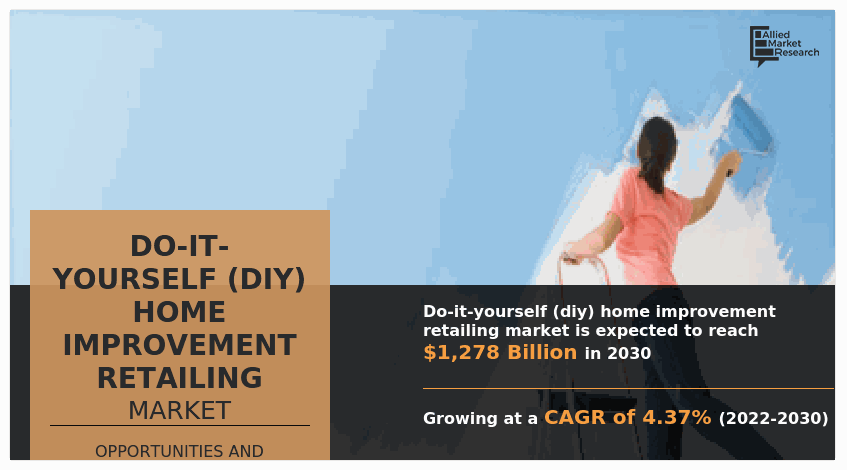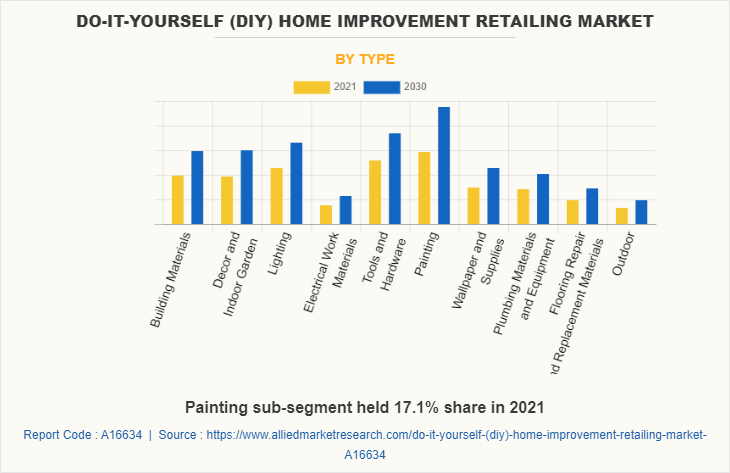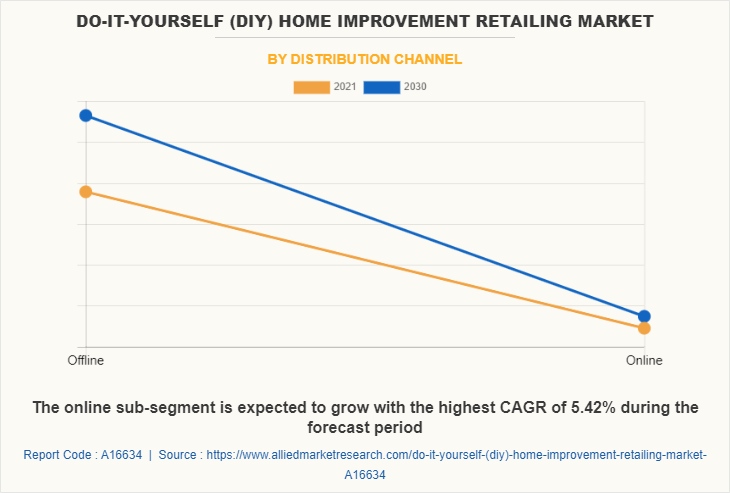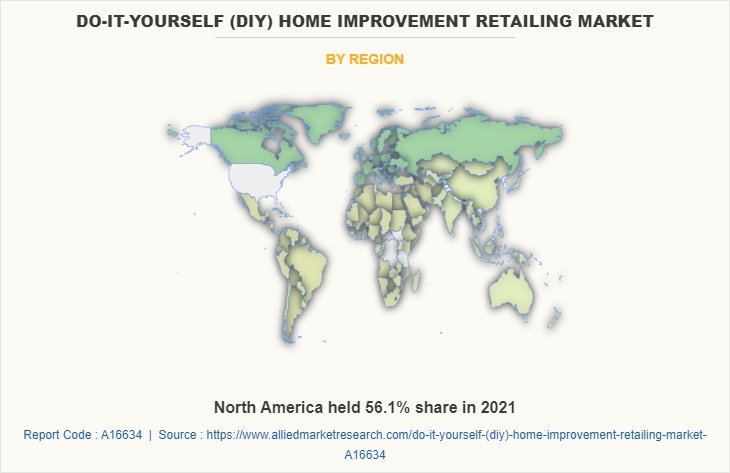Do-It-Yourself (DIY) Home Improvement Retailing Market Research, 2030
The global do-it-yourself (diy) home improvement retailing market was valued at $848.20 billion in 2021, and is projected to reach $1,278.00 billion by 2030, growing at a CAGR of 4.37% from 2022 to 2030.

The do-it-yourself (diy) home improvement retailing market is segmented into Type and Distribution Channel.
DIY is an abbreviation for "do-it-yourself." It entails repairing, maintaining, and improving aspects on your own without the assistance of a professional. After WWII, do-it-yourself projects became increasingly popular. The DIY movement was fueled by developments such as an increase in home purchases and the introduction of home remodeling TV shows. Because of our hectic lifestyles and work schedules, convenient and pleasurable shopping has become critical. Many of the company's major competitors have launched their own online stores to offer low-cost pick-up and delivery. This saves consumers‐™ time and money by reducing the amount of effort required to obtain DIY home improvement supplies. For example, since implementing e-commerce, Walmart's online revenues increased by more than 20% to 25% in 2018.
The growing popularity of do-it-yourself projects among consumers will drive the market growth during the forecast period. This increase will be primarily attributed to an increase in the number of people adopting the zero-waste lifestyle, which is an effective way to reduce plastic waste. Plastic is currently a major polluter of our environment. As a result, DIY manufacturers are focusing heavily on product safety, sustainability, and efficiency, as the use of hazardous chemicals and plastic substances causes environmental pollution when dumped in the environment.
The global market is segmented on the basis of type, distribution channel, and region. By type, market has been divided into building materials, décor & indoor garden, lighting, electrical work materials, tools & hardware, painting, wallpaper & supplies, plumbing materials & equipment, flooring repair & replacement materials, and outdoor. By distribution channel, the analysis has been divided into offline and online. By region, the market is analyzed across North America, Europe, Asia-Pacific, and LAMEA.
The key players profiled in this report include Travis Perkins, Kesko Corporation, Lowe's Companies, Inc., Amazon.com, Inc., Walmart Inc., UBUY Inc., Toolstation, Home Depot Product Authority, LLC, Flipkart.com, UBYLD RETAIL PRIVATE LIMITED.

By type, the market has been divided into building materials, décor & indoor garden, lighting, electrical work materials, tools & hardware, painting, wallpaper & supplies, plumbing materials & equipment, flooring repair & replacement materials, and outdoor. Painting sub-segment accounted for the highest revenue share in 2021. The availability of a wide range of DIY paint products such as terrace wall proofing, self-painting kit, frost effect spray, crackle effect spray, and so on is driving the growth of the painting sub-segment. Notable paint manufacturers such as Berger Paints India Limited and Asian Paints are implementing development strategies such as product innovation to expand their global customer reach. For example, Asian Paints announced the release of 'ezyCR8', a new DIY painting spray product, in August 2020. In the forecast years, such corporate initiatives are expected to drive the sub-segment.

By distribution channel, the offline sub-segment accounted for the highest revenue share in 2021. Because a large percentage of DIY assets are available on the internet, in-store display plays a major role as far as how DIY consumers gain knowledge to manage DIYs. Trying to implement such strategies has boosted revenues for big-box retailers, and that they are equally useful in small and local home renovation business owners. Smaller companies commonly outperform big box stores in terms of customer assistance and shop relationships. 70% of any and all DIYers are likely to explore goods throughout, even though the final purchase is made available on the internet, as well as millennial homeowners are much more inclined to seek out and purchase quality products in-store, particularly paint.

By region, the Asia-Pacific region's do-it-yourself (DIY) home improvement retailing market share is expected to grow the fastest during the forecast period. Increasing cutting-edge DIY product innovation, as well as technological advancement, are some of the key factors that will drive the Asian market forward. Furthermore, the increase in urbanization in Asian countries will accelerate the market. Countries such as China and India are expected to thrive as the world's urbanization accelerates. According to a UN (United Nations) study, India has 416 million urban residents compared to 255 million in China. Furthermore, business expansion and private-public strategic alliances will drive the size of the do-it-yourself (DIY) home improvement retailing market in the near future.
KEY BENEFITS FOR STAKEHOLDERS
- The report provides the global do-it-yourself (DIY) home improvement retailing market size for 2021 and a yearly forecast from 2022 to 2030. In addition, the deliverable will highlight the global do-it-yourself (DIY) home improvement retailing market share and global do-it-yourself (DIY) home improvement retailing market demand for each segment, region, and country(s).
- The report provides an in-depth analysis of the global do-it-yourself (DIY) home improvement retailing market trends and global do-it-yourself (DIY) home improvement retailing market forecast.
- This report highlights the Do-It-Yourself (DIY) Home Improvement Retailing Market Opportunity, key market drivers, and restraints, along with the impact analyses during the forecast period.
- Porter‐™s five forces analysis helps analyze the potential of the buyers & suppliers and the competitive scenario of the global market for strategy building.
- A comprehensive global do-it-yourself (DIY) home improvement retailing market analysis covers factors that drive and restrain the global do-it-yourself (DIY) home improvement retailing market growth.
- The qualitative data in this report aims on market dynamics, trends, and developments.
IMPACT OF COVID-19 ON THE GLOBAL DO-IT-YOURSELF (DIY) HOME IMPROVEMENT RETAILING MARKET
- The global do-it-yourself (DIY) home improvement retailing industry has grown significantly in recent years and is expected to continue growing at a significant rate throughout the forecast period. The growing popularity of DIY products among consumers, as well as the significant increase in retail suppliers' adoption of innovative technologies, are expected to drive the growth of the global market in the forecast years.
- However, the COVID-19 emergency had a significant impact on the global market. Despite predictions of a negative impact on market growth during the lockdown period, the market maintained its growth trajectory due to increased adoption of growth strategies such as geographical expansions and strategic investments made by major players.
- The do-it-yourself (DIY) home improvement retailing industry grew significantly during the COVID-19 flu epidemic. DIYers in both developed and developing countries were devoting time to completing home improvement projects because a majority of people were under COVID-19 lockdown. The vast majority of DIYers are gardening in order to improve their customers' living spaces and keep them entertained during the lockdown. Such factors are driving the demand for DIY products in the midst of COVID-19
Do-It-Yourself (DIY) Home Improvement Retailing Market Report Highlights
| Aspects | Details |
| By Type |
|
| By Distribution Channel |
|
| By Region |
|
| Key Market Players | Amazon, Wesfarmers Limited, Groupe Adeo SA, Kingfisher Plc, The Home Depot, Inc., Lowe's, Ace Hardware Corporation, Menards, Inc, Walmart, Kesko corporation |
Analyst Review
According to the CXOs of the leading companies, the global do-it-yourself (DIY) home improvement retailing market possesses a substantial scope for growth in the future. Consumers' growing interest in do-it-yourself projects will drive market growth during the forecast period. This increase will be attributed primarily to a rise in the number of people who adopt sustainable lifestyle that is an effective method of reducing plastic waste. Plastic is a major polluter of our environment right now. As a result, DIY makers are emphasizing product safety, sustainable development, and efficiency, because the use of dangerous chemicals and plastic substances pollutes the environment when they are discarded. In order to meet zero waste standards, makers are also offering DIY un-paper towels, reusable snack bags, and DIY disinfectant wipes that are easily reusable and recyclable. All such factors and initiatives will drive the global do-it-yourself (DIY) home improvement retailing market growth. According to the CXOs, Asia-Pacific is projected to register faster growth as compared to North American and European markets
The DIY movement was fueled by developments such as an increase in home purchases and the introduction of home remodeling TV shows. Because of our hectic lifestyles and work schedules, convenient and pleasurable shopping has become critical.
The increased interest in DIY home improvement projects is one of the key factors driving growth in of do home improvement retailing market. DIY inside there and home improvement projects have increased in popularity among customers globally as a result of increasing urbanisation and living standards. All such factors will provide the market with additional growth opportunities.
Agreement, business expansion, and product launch are the key growth strategies of global Do-it-yourself (DIY) home improvement retailing market players.
North America will provide more business opportunities for global do-it-yourself (DIY) home improvement retailing market in the future.
Travis Perkins, Kesko Corporation, Lowe's Companies, Inc., Amazon.com, Inc., Walmart Inc., UBUY Inc., Toolstation, Home Depot Product Authority, LLC, Flipkart.com, UBYLD RETAIL PRIVATE LIMITED are the leading market players active in the do-it-yourself (DIY) home improvement retailing market.
Painting held the maximum share of the global Do-it-yourself (DIY) home improvement retailing market in 2021
The report provides an extensive qualitative and quantitative analysis of the current trends and future estimations of the global Do-it-yourself (DIY) home improvement retailing market from 2021 to 2030 to determine the prevailing opportunities
Household sector includes the major customers of global do-it-yourself (DIY) home improvement retailing market.
Loading Table Of Content...


